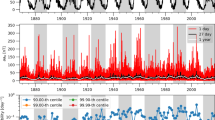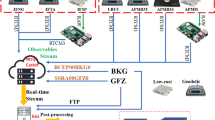Abstract
The ionosphere is a part of the Earth’s atmosphere with complex temporal and spatial distribution and variation. Radio occultation can obtain the vertical distribution of ionosphere, effectively making up for the deficiencies of ground-based Global Navigation Satellite System (GNSS) and other ionospheric sounding technologies; however, the inversion results are subject to the hypothesis model and observation accuracy, making it important to conduct quality assessment. The Constellation Observing System for Meteorology, Ionosphere, and Climate (COSMIC) project started in 2006 and has been renewed since 2019. So far, a large amount of observation data has been accumulated. In this paper, we used the electron density profile data obtained by COSMIC-1 and COSMIC-2 to evaluate the quality. Four evaluation parameters, which only consider the profile’s self-characteristics, were used, and the spatiotemporal distribution characteristics of the data quality were analyzed. The experimental results show that the number of occultation electron density profiles of COSMIC-2 is significantly greater, which is about seven times greater than COSMIC-1. In terms of spatial distribution, the unqualified ratio of COSMIC-1 profiles is less than 25% in most mid-latitude areas and about 15% near the equator, while the unqualified ratio rises to 25–50% in high-latitude areas and reaches 65% or even higher in part of the polar region. The unqualified ratio of COSMIC-2 profiles is about 25% near the equator and about 15% in middle and low-latitude areas. In terms of seasonal distribution, the quality of profiles is the worst in winter, followed by summer, and best in spring and autumn. In terms of day–night distribution, the unqualified ratio is higher at night than daytime and changes significantly at the turn of day and night. The nmF2 and hmF2 of the qualified profiles are significantly higher near the magnetic equator than in other regions, exhibiting a double-peaked phenomenon. The case of a large geomagnetic storm shows that the qualified ratio of inversion results can still maintain about 70% during extremely severe magnetic storms.









Similar content being viewed by others
References
Anthes R and Schreiner W 2019 Six new satellites watch the atmosphere over Earth’s equator; EoS 100, https://doi.org/10.1029/2019EO131779.
Bowhill S A 1974 Satellite transmission studies of spread-F produced by artificial heating of the ionosphere; Radio Sci. 9(11) 975–986.
Chen Y, Shao X, Cao C and Ho S 2021 Simultaneous radio occultation predictions for inter-satellite comparison of bending angle profiles from COSMIC-2 and GeoOptics; Remote Sens. 13(18) 3644.
Cherniak I, Zakharenkova I, Braun J, Wu Q, Pedatella N, Schreiner W, Weiss J and Hunt D 2021 Accuracy assessment of the quiet-time ionospheric F2 peak parameters as derived from COSMIC-2 multi-GNSS radio occultation measurements; J. Space Weather Space Clim. 11 18.
Cucurull L, Kuo Y, Barker D and Rizvi S 2006 Assessing the impact of simulated COSMIC GPS radio occultation data on weather analysis over the Antarctic: A case study; Mon. Wea. Rev. 134(11) 3283–3296.
Deng N, Bai W, Sun Y, Du Q, Xia J, Wang X, Liu C, Cai Y, Meng X, Yin C, Huang F, Hu P, Tan G and Liu X 2022 Evaluation of forward models for GNSS radio occultation data processing and assimilation; Remote Sens. 14(5) 1081.
Garcia-Fernandez M, Hernandez-Pajares M, Juan J M and Sanz J 2005 Performance of the improved Abel transform to estimate electron density profiles from GPS occultation data; GPS Solutions 9(2) 105–110.
Guo P, Xu X and Zhang G 2011 Analysis of the ionospheric equivalent slab thickness based on ground-based GPS/TEC and GPS/COSMIC RO measurements; J. Atmos. Sol.-Terr. Phys. 73(7–8) 839–846.
Hernández-Pajares M, Juan J, Sanz J, Aragón-Àngel À, García-Rigo A, Salazar D and Escudero M 2011 The ionosphere: Effects, GPS modeling and the benefits for space geodetic techniques; J. Geodesy 85 887–907.
Ho S, Anthes R A, Ao C O, Healy S, Horanyi A, Hunt D, Mannucci A J, Pedatella N, Randel W J, Simmons A, Steiner A, Xie F, Yue X and Zeng Z 2020 The COSMIC/FORMOSAT-3 radio occultation mission after 12 years: Accomplishments, remaining challenges, and potential impacts of COSMIC-2; Bull. Am. Meteorol. Soc. 101(7) E1107–E1136.
Horvath I and Lovell B 2010 Large-scale traveling ionospheric disturbances impacting equatorial ionization anomaly development in the local morning hours of the Halloween Superstorms on 29–30 October 2003; J. Geophys. Res.: Space Phys. 115(A4).
Jakowski N, Leitinger R and Angling M 2004 Radio occultation techniques for probing the ionosphere; Ann. Geophys. 47 1049–1066.
Kakinami Y, Liu J, Tsai L C and Oyama K 2010 Ionospheric electron content anomalies detected by a FORMOSAT-3/COSMIC empirical model before and after the Wenchuan Earthquake; Int. J. Remote Sens. 31(13) 3571–3578.
Kelley M C, Wong V K, Aponte N, Coker C, Mannucci A and Komjathy A 2009 Comparison of COSMIC occultation-based electron density profiles and TIP observations with Arecibo incoherent scatter radar data; Radio Sci. 44(04) 1–13.
Krankowski A, Zakharenkova I, Krypiak-Greorczyk A, Shagimuratov I and Wielgosz P 2011 Ionospheric electron density observed by FORMOSAT-3/COSMIC over the European region and validated by ionsonde data; J. Geodesy 85(12) 949–964.
Kursinski E, Hajj G, Leroy S and Herman B 2000 The GPS radio occultation technique; TAO 11(1) 53–114.
Lanyi G and Roth T 1988 A comparison of mapped and measured total ionospheric electron content using global positioning system and beacon satellite observations; Radio Sci. 23(4) 483–492.
Lasota E 2021 Comparison of different machine learning approaches for tropospheric profiling based on COSMIC-2 data; Earth Planet. Space 73(1) 1–18.
Lei J, Syndergaard S, Burns A, Solomon S, Wang W, Zeng Z, Roble R, Wu Q, Kuo Y, Holt J, Zhang S, Hysell D, Rodrigues F and Lin C 2007 Comparison of COSMIC ionospheric measurements with ground-based observations and model predictions: Preliminary results; J. Geophys. Res.: Space Phys. 112(A07308) 1–10.
Linty N, Farasin A, Favenza A and Dovis F 2019 Detection of GNSS ionospheric scintillations based on machine learning decision tree; IEEE Trans. Aerosp. Electron. Syst. 55(1) 303–317.
Liu Z, Skone S, Gao Y and Komjathy A 2005 Ionospheric modeling using GPS data; GPS Solutions 9 63–66.
Liu L, Zhao B, Wan W, Ning B, Zhang M and He M 2009 Seasonal variations of the ionospheric electron densities retrieved from Constellation Observing System for meteorology, ionosphere, and climate mission radio occultation; J. Geophys. Res. 114(1) A02302.
Liu T, Lin C, Lin C, Lee I, Sun Y, Chen S, Chang F, Rajesh P, Hsu C, Matsuo T, Chen C and Tsai H 2022 Retrospect and prospect of ionospheric weather observed by FORMOSAT-3/COSMIC and FORMOSAT-7/COSMIC-2; Terr. Atmos. Ocean. Sci. 33(1) 20.
Matzka J, Stolle C, Yamazaki Y, Bronkalla O and Morschhauser A 2021 The geomagnetic Kp index and derived indices of geomagnetic activity; Space Weather 19(5) e2020SW002641.
Perevalova N, Romanova E and Tashchilin A 2020 Detection of high-latitude ionospheric structures using GNSS; J. Atmos. Sol.-Terr. Phys. 207 105335.
Potula B, Chu Y, Uma G, Hsia H and Wu K 2011 A global comparative study on the ionospheric measurements between COSMIC radio occultation technique and IRI model; J. Geophys. Res.: Space Phys. 116(A2).
Rishbeth H 1998 How the thermospheric circulation affects the ionosphere F2 layer; Atmos. Terr. Phys. 30 1385–1402.
Sai Gowtam V and Tulasi Ram S 2017 An artificial neural network-based ionospheric model to predict NmF2 and hmF2 using long-term data set of FORMOSAT-3/COSMIC radio occultation observations: Preliminary results; J. Geophys. Res.: Space Phys. 122(11) 11,743-11,755.
Sardon E, Rius A and Zarraoa N 1994 Estimation of transmitter and receiver differential biases and the ionospheric total electron content from global positioning system observations; Radio Sci. 29(3) 577–586.
Schreiner W, Sokolovskiy S, Rocken C and Hunt D 1999 Analysis and validation of GPS/MET radio occultation data in the ionosphere; Radio Sci. 34(4) 949–966.
Schreiner W, Rocken C, Sokolovskiy S and Hunt D 2007 Estimates of the precision of GPS radio occultations from COSMIC/FORMOSAT-3 mission; Geophys. Res. Lett. 34(4).
Schreiner W, Weiss J, Anthes R, Chu V, Fong J, Hunt D, Kuo Y, Meehan T, Serafino W, Sjoberg J, Sokolovskiy S, Talaat E, Wee T and Zeng Z 2020 COSMIC-2 radio occultation constellation: First results; Geophys. Res. Lett. 47(4) e2019GL086841.
Sokolovskiy S, Rocken C, Lenschow D, Kuo Y, Anthes A, Schreiner W and Hunt D 2007 Observing the moist troposphere with radio occultation signals from COSMIC; Geophys. Res. Lett. 34(18), https://doi.org/10.1029/2006GL030458.
Stolle C, Lühr H, Rother M and Balasis G 2006 Magnetic signatures of equatorial spread F as observed by the CHAMP satellite; J. Geophys. Res.: Space Phys. 111(A2).
Straus P, Schreiner W, Santiago J, Talaat E and Lin C 2020 FORMOSAT-7/COSMIC-2 TGRS space weather provisional data release 1; Technical Report, NOAA, USAF and NSP.
Uma G, Brahmanandam P and Chu Y 2016 A long-term study on the deletion criterion of questionable electron density profiles caused by ionospheric irregularities – COSMIC radio occultation technique; Adv. Space Res. 57(12) 2452–2463.
Ware R, Exner M, Feng D, Gorbunov M, Hardy K, Herman B, Kuo Y, Meehan T, Melbourne W, Rocken C, Schreiner W, Sokolovskiy S, Solheim F, Zou X, Anthes R, Businger S and Trenberth K 1996 GPS sounding of the atmosphere from low earth orbit: Preliminary results; Bull. Am. Meteorol. Soc. 77(1) 19–40.
Xu X, Li J, Luo J and Sun F 2018 Quality check of COSMIC occultation electron density profiles; J. Nat. Univ. Def. Technol. 40(05) 54–59 (in Chinese).
Xu J, Wang Q, Ke F, Zhang B, Yan C and Zhang H 2021 Analysis of ionospheric parameters retrieved from Feng-Yun 3C and COSMIC radio occultation; Adv. Space Res. 68(1) 214–224.
Yang K, Chu Y, Su C, Ko H and Wang C 2009 An examination of FORMOSAT-3/COSMIC ionospheric electron density profile: Data quality criteria and comparisons with the IRI model; Terrestrial Atmospheric and Oceanic Sciences 20(1) 193–206.
Yue X, Schreiner W, Pedatella N, Richard A, Mannucci A, Straus P and Liu J 2014 Space Weather Observations by GNSS radio occultation: From FORMOSAT-3/COSMIC to FORMOSAT-7/COSMIC-2; Space Weather 12(11) 616–621.
Acknowledgements
Thanks for the COSMIC electron density profiles provided by UCAR. This research was supported by the National Natural Science Foundation of China (41604017), Guangdong Basic and Applied Basic Research Foundation (2019A1515011268) and the Guangzhou Science and Technology Plan Project (202102020380).
Author information
Authors and Affiliations
Contributions
Rui Zhang and Na Fu contributed to the conception of the study; Rui Zhang contributed to analysis and manuscript preparation; Na Fu and Qixin Pan performed the experiment; Na Fu performed the data analyses and wrote the manuscript; Xiaojing Tian, Shaoqiu Long, and Chaolong Yao helped perform the analysis with constructive discussions.
Corresponding author
Additional information
Communicated by T Narayana Rao
Rights and permissions
About this article
Cite this article
Fu, N., Zhang, R., Pan, Q. et al. Quality assessment of the ionospheric density profiles based on long-term COSMIC 1 and 2 radio occultation observations. J Earth Syst Sci 132, 175 (2023). https://doi.org/10.1007/s12040-023-02190-2
Received:
Revised:
Accepted:
Published:
DOI: https://doi.org/10.1007/s12040-023-02190-2




